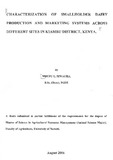| dc.description.abstract | To characterize smallholder dairy production systems across different agro-ecological
zones in Kiambu district, identify constraints and opportunities to improve profitability
by optimizing resource use based on key determinants to make decisions on choice of
appropriate risk management (production and marketing) strategies data was collected
through households' survey. The methodology used for data collection through purposive multi stage design using Probability Proportion to Size (PPS) sampling design was based on a conceptual framework for dairy systems analysis of production-to-consumption approach developed by ILRI. One hundred and thirty four smallholder dairy households were randomly selected in three agro-ecological zones namely: lower highlands, upper midlands and lower midlands in Limuru, Kiambaa and Ndeiya divisions respectively.
Principal components analyses and cluster analysis were used to classify smallholder
farms in terms of risk management strategies, level of household resources, level of dairy intensification and level of access to services and markets. Four classes of dairy system clusters were identified. The results showed that 41.8% and 35.1% of farmers either marketed their milk through the cooperatives and informal marketing channels
respectively. Policies to improve the operational and pricing efficiencies of dairy
cooperatives would have a self-accelerating effect on productivity. Informal milk
marketing channels operate without a legal framework. Regulations to guide their
operations should be formulated.
Econometric logit models were used to analyze the determinants of small-scale dairy
farmers' adoption of various production and marketing strategies. Logit models of
changes in livestock numbers, use of purchased concentrate feeds and forage
management practices, routine animal health and veterinary services were non-significant (p > 0.05). However, logit model of milk marketing through cooperative channel was significant (p < 0.05).
Eleven explanatory variables were significant (p < 0.05) in explaining smallholder
farmers' adoption of milk marketing through the cooperative channel. Lower midlands,
leased land, price of milk (KES /kg) and total farm acreage negatively influenced
farmers' adoption of milk marketing through the cooperative channel. Lower highlands,
hired permanent labour, number of cows milked, average milk production per cow (kg!
day), dairy cooperative as a source of animal production information, household head
worked off-farm and availability of credit services had positive influence.
The farm profit formula was used to estimate the costs of production and returns (KES
/kg) of milk produced. Fixed costs were ignored since were unrelated to higher levels of
milk production and do not affect the optimal combination of the variable inputs.
Majority of Kenyans' small-scale farmers own most of their fixed costs and can therefore
make decisions based on profits only. The computation of production costs and revenues (from the milk sold or consumed by households and calves) were based on the dairy enterprise only. The results showed that the cost of production and unit profit were 16.90 and 6.30, 19.05 and 2.30, and 18.05 and 3.45 KES /kg of milk produced in upper midlands, lower highlands and lower midlands respectively. These estimates of costs of production and returns are important for policy makers and development planners when making decisions related to availability and cost of any risk management strategy in dairy enterprise.
In addition, there were no significant differences (p > 0.05) between costs of production
in the three agro-ecological zones. This was a reflection of similarities in levels of
intensification in the three agro-ecological zones. However, the variations of returns
(KES/ kg) of milk were significant (p < 0.05) between lower highlands and upper
midlands, an indication that farmers in the later agro-ecological zone were making much
more profit from milk than those in the former probably due to higher milk prices. The
survey showed that dairy enterprise was the most important income generating farming
activity in 96.7% of households in Kiambu district and probably the most important
farming activity in the Kenya highlands. | en |

